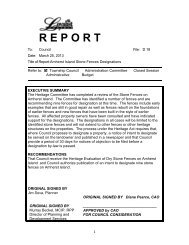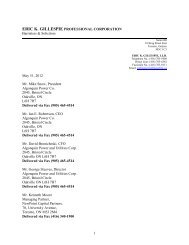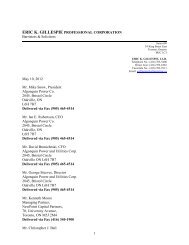a letter regarding Amherst Island - Amherst Island Wind Info
a letter regarding Amherst Island - Amherst Island Wind Info
a letter regarding Amherst Island - Amherst Island Wind Info
Create successful ePaper yourself
Turn your PDF publications into a flip-book with our unique Google optimized e-Paper software.
8850, Second Concession Rd.,<br />
Stella, ON K0H 2S0<br />
Oct. 20 th , 2010,<br />
Mr. Colin Anderson,<br />
Ontario Power Authority,<br />
120, Adelaide St. W., Suite 1600,<br />
Toronto, ON M5H 1T1<br />
Dear Mr. Anderson,<br />
I am writing concerning the proposed wind energy project for <strong>Amherst</strong> <strong>Island</strong> that<br />
<strong>Wind</strong>lectric has submitted to OPA for approval under the renewable energy FIT<br />
program. First, I have no sense of exactly what has been proposed because these<br />
companies hold their cards very close to their chests. Nevertheless, there was an<br />
earlier proposal for up to 200 MW of wind power and Algonquin Power, one of the<br />
developers behind <strong>Wind</strong>lectric, mentions plans for projects in eastern Ontario of up to<br />
80 MW in its most recent company report. I would like to explain why a project on<br />
<strong>Amherst</strong> <strong>Island</strong> is a very bad idea.<br />
Marginal <strong>Wind</strong> Resource<br />
According to the Ministry of Natural Resources, <strong>Amherst</strong> <strong>Island</strong> has only acceptable<br />
wind speed at 80 metres (6.5 m/s on average). The small regions on the map* that<br />
correspond to 7.5 m/s wind speed will be excluded as either zoned shoreline residential<br />
or isolated by land that is zoned environmentally protected.<br />
A cursory glance at the Ontario <strong>Wind</strong> Atlas (see page 2) shows that there are large<br />
areas of Ontario, many with low population density and closer to large urban centres,<br />
with a similar wind speed average. There are also large areas with wind speed<br />
averages in the “very good” classification of 7.5 m/s on average. As you will know, the<br />
1
power derived from a turbine varies as the third power of the wind speed. The third<br />
power of the ratio of 7.5 m/s to 6.5 m/s is 1.5 or a 50% premium. Put another way, a<br />
wind project on <strong>Amherst</strong> <strong>Island</strong> will have an annual average capacity factor of less than<br />
20% compared with the 26% average for the eight projects in operation in Ontario for<br />
the full year July 2009 to June 2010. See the attached report based upon hourly<br />
measurements provided by IESO. These eight projects are all in “very good”<br />
classification zones.<br />
Even compared to neighbouring regions at the eastern end of Lake Ontario, the wind<br />
resource on <strong>Amherst</strong> <strong>Island</strong> is poor:<br />
2
I would also like to point out that, in a report commissioned by the OPA from Helimax to<br />
investigate potential sites for wind energy, <strong>Amherst</strong> <strong>Island</strong> did not make the list of 60<br />
sites. That is, it did not even rate “least favoured”. The ranking factors used by Helimax<br />
were: a) wind speed; b) megawatt capacity density; c) road access; d) social factors.<br />
<strong>Wind</strong>lectric does have its own wind speed map based upon measurement from 3 test<br />
towers and upper atmosphere modeling. It shows somewhat higher wind speeds than<br />
does the Ontario <strong>Wind</strong> Atlas. Nevertheless the Ontario <strong>Wind</strong> Atlas will give a better<br />
picture of comparative wind speeds across Ontario and hence comparative capacity<br />
factors.<br />
Project Area<br />
<strong>Amherst</strong> <strong>Island</strong> does not have the land area for a large project. <strong>Wind</strong>lectric has<br />
announced only that the earlier proposal was to be for up to 199 MW of nameplate<br />
power. The total area of <strong>Amherst</strong> <strong>Island</strong> is 16,500 acres. Of this, I estimate that 3000<br />
acres is zoned either environmentally protected or environmentally sensitive and 2500<br />
acres is zoned either hamlet or shoreline residential. All of this was “off-limits” under the<br />
Official Plan Amendment of Loyalist Township. This will remain so under the REA<br />
process defined by the Green Energy Act. These numbers do not include the area of<br />
buffer zones around these four zone classifications. This leaves less than 11,000<br />
acres. Of course, only part of these 11,000 acres will have been leased to <strong>Wind</strong>lectric.<br />
Algonquin Power has one operating wind energy project, at St. Leon in Manitoba. For<br />
that project the nameplate power is 99 MW and the area occupied is 23,000 acres. A<br />
similar density on <strong>Amherst</strong> <strong>Island</strong> would limit the project to considerably less than 50<br />
MW, surely not viable given the expected low capacity factor and the expense of an<br />
underwater cable of 3 km or more, depending upon where <strong>Wind</strong>lectric plans to locate<br />
the transformer sub-station.<br />
It seems that not many are aware that wind turbines generate a considerable wake<br />
behind them. This means that there is a wind deficit as well as turbulence downwind of<br />
a turbine. The wind deficit takes away from the capacity factor of the downwind turbines<br />
and the excess turbulence contributes to wear and tear on those turbines. These things<br />
are well known as a result of government-sponsored work in Europe, notably in<br />
Denmark. This deficit, together with general hubris to rouse investors, is perhaps why<br />
the 24% capacity factor of the Wolfe <strong>Island</strong> facility is so much lower than the 34% that<br />
was being claimed by the developer even up to the six month mark of operation. It is<br />
clear that any project developed on <strong>Amherst</strong> <strong>Island</strong> would have to be high density and<br />
will suffer from wind deficit.<br />
I have attended two talks by John Foster, a public relations representative for Transalta,<br />
on the design and construction of the Wolfe <strong>Island</strong> wind energy generating facility (One<br />
to the Probus Society of Kingston and one to the Kingston chapter of the IEEE). In both<br />
talks he mentioned that it was four times more difficult to build on an island. Granting<br />
some exaggeration, the point is well taken that the logistics are challenging when<br />
putting any infrastructure on an island. It would be worse for <strong>Amherst</strong> <strong>Island</strong>: the ferry is<br />
smaller and side- loading rather than end-loading for Wolfe <strong>Island</strong>; the roads are of a<br />
3
lower standard; there is a spine down the island and I cannot imagine how turbine parts<br />
would be moved without major earth-moving; there are not the facilities for hosting work<br />
crews; there are many large lots that have not been optioned so that those that are form<br />
a haphazard patchwork.<br />
Opposition to the Project.<br />
There is on <strong>Amherst</strong> <strong>Island</strong> a large and organized opposition to a large wind energy<br />
project. The incorporated Association for the Protection of <strong>Amherst</strong> <strong>Island</strong> (APAI) has<br />
about 150 members and 175 people signed a petition to Loyalist Township to oppose a<br />
large project. This from a population of 450 year-round and perhaps up to 800 with<br />
summer cottagers. There are many others who do not want to declare themselves for<br />
business or family reasons or just so as not to upset neighbours. The opposition is not<br />
against wind energy as such; the reasons are the noise, flicker and safety problems<br />
associated with close proximity to wind turbines, the ensuing health problems, concern<br />
with ground-water problems, environmental concerns (<strong>Amherst</strong> <strong>Island</strong> is one of<br />
Canada’s “Important Bird Areas”) and destruction of a beautiful island. This association<br />
will oppose a large-scale wind energy project by every possible means.<br />
Until recently, the options to lease land were held by Gaia Power and Canadian Hydro<br />
Developers (CHD) which had bought out the interest of Vector Power several years<br />
ago. CHD had stated in a <strong>letter</strong> to CPAI, the precursor to APAI, that if they were not<br />
wanted by the community they would develop elsewhere where they were welcome.<br />
CHD abandoned development on <strong>Amherst</strong> <strong>Island</strong>, presumably because of insufficient<br />
wind, because of a significant number of islanders who did not want them and because<br />
they realized that a proposal for <strong>Amherst</strong> <strong>Island</strong> would trigger a federal Cumulative<br />
Environmental Impact Assessment (CEIA) which could well sink the project. As I hope<br />
you are aware, CHD stated categorically that there would be “no development on<br />
<strong>Amherst</strong> <strong>Island</strong> in the foreseeable future” in order to forestall a CEIA for the Wolfe <strong>Island</strong><br />
wind energy project. The quote is from the Wolfe <strong>Island</strong> Environmental Review Report.<br />
Impact on Birds and Bats<br />
As noted above, <strong>Amherst</strong> <strong>Island</strong> is an “Important Bird Area” (IBA). Rather than make<br />
my own remarks, I will quote from respected wildlife organizations; the two full <strong>letter</strong>s<br />
and full motion from Ontario Nature are available by sending me an e-mail.<br />
From Nature Canada (Mara Kerry, Director of Conservation) in a <strong>letter</strong> to you, dated<br />
Oct. 15 th , 2008:<br />
“<strong>Amherst</strong> <strong>Island</strong> is one such IBA. The entire island is internationally recognized as an<br />
IBA due to the high numbers of migrating Brant that are found there in the Spring. The<br />
variety of habitats on the island also make it a renowned site for a wide variety of other<br />
birds including shorebirds (such as Spring-migrating Dunlin), raptors (particularly<br />
significant are the island’s wintering concentrations of hawks and owls), and land-birds<br />
(such as large concentrations of migrating swallows).”<br />
And later:<br />
“<strong>Wind</strong> energy …. (3 paragraphs to be inserted here)<br />
4
Letter from Cataraqui Region Conservation Area (Mara Shaw, Watershed<br />
Management Coordinator) to Mr. John Friberg, Ontario Ministry of Natural Resources,<br />
as a response to EBR 011-0907 (Offshore <strong>Wind</strong> Power: Consideration of Additional<br />
Areas to be Removed from Future Development); dated October 13 th , 2010:<br />
“Exclusion Specific to Eastern Lake Ontario<br />
On the basis of the recommended exclusion zones above, CRCA staff recommend that<br />
the shoals of Eastern Lake Ontario be excluded from offshore wind turbine installation<br />
until further studies are conducted and only then if the results indicate that no negative<br />
impact would be incurred on the region’s natural heritage.<br />
Staff notes that the proposed location of the Wolfe <strong>Island</strong> Shoals <strong>Wind</strong> Project is in the<br />
midst of three IBAs: Pigeon <strong>Island</strong> (ON041) which is globally significant for<br />
congregatory species and nationally significant for its colonial water-bird and sea-bird<br />
concentrations; Wolfe <strong>Island</strong> (ON037), which is globally significant for congregatory<br />
species and continentally significant for both congregatory species and waterfowl<br />
concentrations; and <strong>Amherst</strong> <strong>Island</strong> (ON062) which is globally and continentally<br />
significant for congregatory species. The impact of off-shore wind turbines on the<br />
significant populations of waterfowl and shorebirds, migrating and congregating birds<br />
has not been studied in inland waters. Initial results from the terrestrially-based Wolfe<br />
<strong>Island</strong> wind turbines indicate increased bird and bat mortality which has currently only<br />
reported results from its first year of monitoring.”<br />
At its 2010 Annual General Meeting, Ontario Nature passed the following motion:<br />
“Be it resolved that Ontario Nature – Federation of Ontario Naturalists 1) calls upon the<br />
government of Ontario to place a moratorium on wind farm development within 5 km of<br />
known significance to migrating birds and National Parks, Provincial Parks, and<br />
Important Bird Areas, until multi-year radar studies of bird migration are conducted at<br />
proposed development sites; and 2) urges the government to protect these sites from<br />
wind farm development if studies determine that they have significant bird migration<br />
concentrations, for example of over 100,000 birds in a season or are found to be<br />
situated within major migratory pathways.”<br />
The motion was moved by Myrna Wood (Prince Edward County Field Naturalists) and<br />
seconded by Erwin Batalla (Kingston Field Naturalists).<br />
You are probably aware of the very negative publicity attracted by the wind energy<br />
industry over the initial report on the bird and bat kill on Wolfe <strong>Island</strong>.<br />
I urge the Ontario Power Authority to reject any wind energy proposal for <strong>Amherst</strong><br />
<strong>Island</strong> before too many resources have been expended. In my opinion, this project is<br />
marginal at best, is environmentally distressing to people and wildlife, and the very<br />
strong opposition will at the least cause a long delay in the approval process and at best<br />
put a stop to it.<br />
5
Yours sincerely,<br />
John Harrison<br />
harrisjp@physics.queensu.ca<br />
encl: Capacity Factor of Ontario <strong>Wind</strong> Energy Generating Facilities (July 2009 to June<br />
2010).<br />
*All maps are for wind speed at a height of 80 metres, a typical turbine hub height.<br />
6








